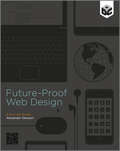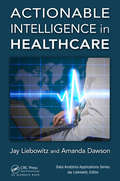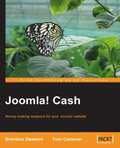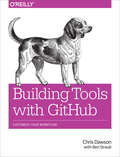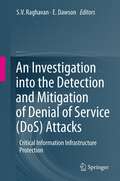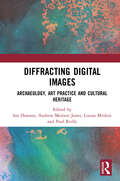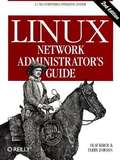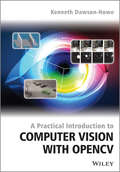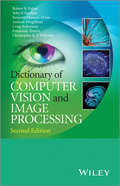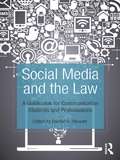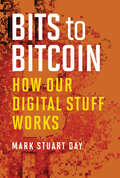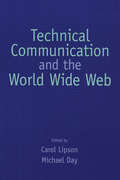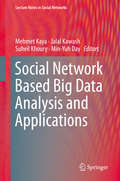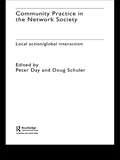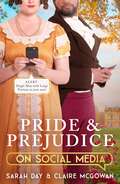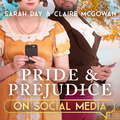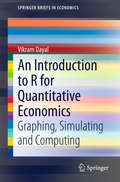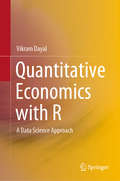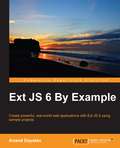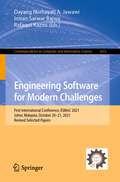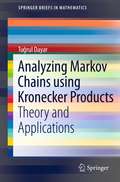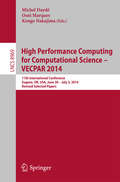- Table View
- List View
Future-Proof Web Design
by Alexander DawsonBest practices for flexible design that meet common challengesThe web is constantly changing and evolving with an increased range of devices, browsers, and standards that need to be considered in design. Web designers know they must stay sharp in order to keep up with the rapid pace of technology change. This much-needed book teaches the art of flexible and adaptable design that can work easily with new devices, technologies, and standards. You'll quickly discover how this resource stands out from the crowd as it provides you with a roadmap for ensuring that your designs are stable and flexible enough to handle whatever technology changes are coming in the future.Takes you on a journey of discovery as you learn how to prepare yourself for undefined changes in the dynamic environment of web designShares straightforward tips for adopting a forward-thinking approach to the subject of web evolutionUncovers the essential skills you need in order to survive the future of the web Using the fundamental skills and processes laid out in this roadmap, you'll be able to boost your stability and flexibility while coding with confidence.
Actionable Intelligence in Healthcare (Data Analytics Applications)
by Amanda Dawson Jay LiebowitzThis book shows healthcare professionals how to turn data points into meaningful knowledge upon which they can take effective action. Actionable intelligence can take many forms, from informing health policymakers on effective strategies for the population to providing direct and predictive insights on patients to healthcare providers so they can achieve positive outcomes. It can assist those performing clinical research where relevant statistical methods are applied to both identify the efficacy of treatments and improve clinical trial design. It also benefits healthcare data standards groups through which pertinent data governance policies are implemented to ensure quality data are obtained, measured, and evaluated for the benefit of all involved. Although the obvious constant thread among all of these important healthcare use cases of actionable intelligence is the data at hand, such data in and of itself merely represents one element of the full structure of healthcare data analytics. This book examines the structure for turning data into actionable knowledge and discusses: The importance of establishing research questions Data collection policies and data governance Principle-centered data analytics to transform data into information Understanding the "why" of classified causes and effects Narratives and visualizations to inform all interested parties Actionable Intelligence in Healthcare is an important examination of how proper healthcare-related questions should be formulated, how relevant data must be transformed to associated information, and how the processing of information relates to knowledge. It indicates to clinicians and researchers why this relative knowledge is meaningful and how best to apply such newfound understanding for the betterment of all.
Joomla! Cash
by Brandon Dawson Tom CanavanThis book is a fast and easy read, taking the reader from the inception of an idea, to a fully working cash-generating website built on Joomla! This book is suitable for business people with a medium level of technical skill who need a good primer on how to implement a cash-generating website. Those unfamiliar with Joomla! Would benefit from reading Building Websites with Joomla! 1.5 Beta 1.
Building Tools with GitHub
by Chris Dawson Ben StraubFor your next project on GitHub, take advantage of the service's powerful API to meet your unique development requirements. This practical guide shows you how to build your own software tools for customizing the GitHub workflow. Each hands-on chapter is a compelling story that walks you through the tradeoffs and considerations for building applications on top of various GitHub technologies.If you're an experienced programmer familiar with GitHub, you'll learn how to build tools with the GitHub API and related open source technologies such as Jekyll (site builder), Hubot (NodeJS chat robot), and Gollum (wiki).Build a simple Ruby server with Gist API command-line tools and Ruby's "Octokit" API clientUse the Gollum command-line tool to build an image management applicationBuild a GUI tool to search GitHub with PythonDocument interactions between third-party tools and your codeUse Jekyll to create a fully-featured blog from material in your GitHub repositoryCreate an Android mobile application that reads and writes information into a Jekyll repositoryHost an entire single-page JavaScript application on GitHubUse Hubot to automate pull request reviews
An Investigation into the Detection and Mitigation of Denial of Service (DoS) Attacks: Critical Information Infrastructure Protection
by E Dawson S. V. RaghavanAround the globe, nations face the problem of protecting their Critical Information Infrastructure, normally referred to as Cyber Space. In this monograph, we capture FIVE different aspects of the problem; High speed packet capture, Protection through authentication, Technology Transition, Test Bed Simulation, and Policy and Legal Environment. The monograph is the outcome of over three years of cooperation between India and Australia.
Diffracting Digital Images: Archaeology, Art Practice and Cultural Heritage
by Ian Dawson Andrew Meirion Jones Louisa Minkin Paul ReillyDigital imaging techniques have been rapidly adopted within archaeology and cultural heritage practice for the accurate documentation of cultural artefacts. But what is a digital image, and how does it relate to digital photography? The authors of this book take a critical look at the practice and techniques of digital imaging from the stance of digital archaeologists, cultural heritage practitioners and digital artists. Borrowing from the feminist scholar Karen Barad, the authors ask what happens when we diffract the formal techniques of archaeological digital imaging through a different set of disciplinary concerns and practices. Diffracting exposes the differences between archaeologists, heritage practitioners and artists, and foregrounds how their differing practices and approaches enrich and inform each other. How might the digital imaging techniques used by archaeologists be adopted by digital artists, and what are the potentials associated with this adoption? Under the gaze of fine artists, what happens to the fidelity of the digital images made by archaeologists, and what new questions do we ask of the digital image? How can the critical approaches and practices of fine artists inform the future practice of digital imaging in archaeology and cultural heritage? Diffracting Digital Images will be of interest to students and scholars in archaeology, cultural heritage studies, anthropology, fine art, digital humanities, and media theory.
Linux Network Administrator's Guide, Second Edition
by Terry Dawson Olaf KirchFully updated, this impressive, comprehensive introduction to networking on Linux now covers firewalls, including the use of ipchains and iptables (netfilter), masquerading, and accounting. Other new topics include Novell (NCP/IPX) support and INN (news administration). Original material on serial connections, UUCP, routing and DNS, mail and News, SLIP and PPP, NFS, and NIS has been thoroughly updated.
A Practical Introduction to Computer Vision with OpenCV
by Kenneth Dawson-HoweExplains the theory behind basic computer vision and provides a bridge from the theory to practical implementation using the industry standard OpenCV librariesComputer Vision is a rapidly expanding area and it is becoming progressively easier for developers to make use of this field due to the ready availability of high quality libraries (such as OpenCV 2). This text is intended to facilitate the practical use of computer vision with the goal being to bridge the gap between the theory and the practical implementation of computer vision. The book will explain how to use the relevant OpenCV library routines and will be accompanied by a full working program including the code snippets from the text. This textbook is a heavily illustrated, practical introduction to an exciting field, the applications of which are becoming almost ubiquitous. We are now surrounded by cameras, for example cameras on computers & tablets/ cameras built into our mobile phones/ cameras in games consoles; cameras imaging difficult modalities (such as ultrasound, X-ray, MRI) in hospitals, and surveillance cameras. This book is concerned with helping the next generation of computer developers to make use of all these images in order to develop systems which are more intuitive and interact with us in more intelligent ways. Explains the theory behind basic computer vision and provides a bridge from the theory to practical implementation using the industry standard OpenCV librariesOffers an introduction to computer vision, with enough theory to make clear how the various algorithms work but with an emphasis on practical programming issuesProvides enough material for a one semester course in computer vision at senior undergraduate and Masters levels Includes the basics of cameras and images and image processing to remove noise, before moving on to topics such as image histogramming; binary imaging; video processing to detect and model moving objects; geometric operations & camera models; edge detection; features detection; recognition in imagesContains a large number of vision application problems to provide students with the opportunity to solve real problems. Images or videos for these problems are provided in the resources associated with this book which include an enhanced eBook
Dictionary of Computer Vision and Image Processing
by Kenneth Dawson-Howe Toby P. Breckon Christopher K. Williams Andrew Fitzgibbon Craig Robertson Robert B. Fisher Emanuele TruccoWritten by leading researchers, the 2nd Edition of the Dictionary of Computer Vision & Image Processing is a comprehensive and reliable resource which now provides explanations of over 3500 of the most commonly used terms across image processing, computer vision and related fields including machine vision. It offers clear and concise definitions with short examples or mathematical precision where necessary for clarity that ultimately makes it a very usable reference for new entrants to these fields at senior undergraduate and graduate level, through to early career researchers to help build up knowledge of key concepts. As the book is a useful source for recent terminology and concepts, experienced professionals will also find it a valuable resource for keeping up to date with the latest advances.New features of the 2nd Edition:Contains more than 1000 new terms, notably an increased focus on image processing and machine vision terms;Includes the addition of reference links across the majority of terms pointing readers to further information about the concept under discussion so that they can continue to expand their understanding;Now available as an eBook with enhanced content: approximately 50 videos to further illustrate specific terms; active cross-linking between terms so that readers can easily navigate from one related term to another and build up a full picture of the topic in question; and hyperlinked references to fully embed the text in the current literature.
Social Media and the Law: A Guidebook for Communication Students and Professionals
by Daxton R. “Chip” StewartSocial media platforms like Facebook, Twitter, Pinterest, YouTube, and Flickr allow users to connect with one another and share information with the click of a mouse or a tap on a touchscreen—and have become vital tools for professionals in the news and strategic communication fields. But as rapidly as these services have grown in popularity, their legal ramifications aren’t widely understood. To what extent do communicators put themselves at risk for defamation and privacy lawsuits when they use these tools, and what rights do communicators have when other users talk about them on social networks? How can an entity maintain control of intellectual property issues—such as posting copyrighted videos and photographs—consistent with the developing law in this area? How and when can journalists and publicists use these tools to do their jobs without endangering their employers or clients? In Social Media and the Law, eleven media law scholars address these questions and more, including current issues like copyright, online impersonation, anonymity, cyberbullying, sexting, and WikiLeaks. Students and professional communicators alike need to be aware of laws relating to defamation, privacy, intellectual property, and government regulation—and this guidebook is here to help them navigate the tricky legal terrain of social media.
Teacher Professionalism During the Pandemic: Courage, Care and Resilience
by Christopher Day Helen Victoria Smith Ruth Graham Despoina AthanasiadouThis insightful book uniquely charts the events, experiences and challenges faced by teachers during and beyond the COVID-19 pandemic including periods of national lockdowns and school closures. Research-based and evidence informed, this key title explores the multiple media outputs created by teachers in a variety of different socio-economic contexts. The authors reflect on their stories through a series of themed analyses, as well as describing and discussing key issues related to the enactment of teacher professionalism in challenging times. With fascinating vignettes and interview extracts that reinforce the idea that teachers can manage rather than survive, this book unveils a strong sense of moral purpose, professional identity, commitment, care and resilience. It will be of interest to teachers, head teachers and teacher educators internationally.
Bits to Bitcoin: How Our Digital Stuff Works (The\mit Press Ser.)
by Mark Stuart DayAn accessible guide to our digital infrastructure, explaining the basics of operating systems, networks, security, and other topics for the general reader.Most of us feel at home in front of a computer; we own smartphones, tablets, and laptops; we look things up online and check social media to see what our friends are doing. But we may be a bit fuzzy about how any of this really works. In Bits to Bitcoin, Mark Stuart Day offers an accessible guide to our digital infrastructure, explaining the basics of operating systems, networks, security, and related topics for the general reader. He takes the reader from a single process to multiple processes that interact with each other; he explores processes that fail and processes that overcome failures; and he examines processes that attack each other or defend themselves against attacks. Day tells us that steps are digital but ramps are analog; that computation is about “doing something with stuff” and that both the “stuff” and the “doing” can be digital. He explains timesharing, deadlock, and thrashing; virtual memory and virtual machines; packets and networks; resources and servers; secret keys and public keys; Moore's law and Thompson's hack. He describes how building in redundancy guards against failure and how endpoints communicate across the Internet. He explains why programs crash or have other bugs, why they are attacked by viruses, and why those problems are hard to fix. Finally, after examining secrets, trust, and cheating, he explains the mechanisms that allow the Bitcoin system to record money transfers accurately while fending off attacks.
Technical Communication and the World Wide Web
by Michael Day Carol LipsonOver the past decade, the World Wide Web has dramatically changed the face of technical communication, but the teaching of writing has thus far altered very little to accommodate this rapidly changing context. Technical Communication and the World Wide Web offers substantial and broadly applicable strategies for teaching global communication issues affecting writing for the World Wide Web.Editors Carol Lipson and Michael Day have brought together an exceptional group of experienced and well-known teacher-scholars to develop this unique volume addressing technical communication education. The chapters here focus specifically on curriculum issues and the teaching of technical writing for the World Wide Web, contributing a blend of theory and practice in proposing changes in curriculum and pedagogy. Contributors offer classroom examples that teachers at all levels of experience can adapt for their own classes. The volume provides comprehensive coverage of the technical communication curriculum, from the two-year level to the graduate level; from service courses to degree programs.This volume is an important and indispensable resource for technical writing educators, and it will serve as an essential reference for curriculum and pedagogy development in technical communication programs.
Social Network Based Big Data Analysis and Applications (Lecture Notes In Social Networks Ser.)
by Min-Yuh Day Suheil Khoury Jalal Kawash Mehmet KayaThis book is a timely collection of chapters that present the state of the art within the analysis and application of big data. Working within the broader context of big data, this text focuses on the hot topics of social network modelling and analysis such as online dating recommendations, hiring practices, and subscription-type prediction in mobile phone services. Manuscripts are expanded versions of the best papers presented at the IEEE/ACM International Conference on Advances in Social Networks Analysis and Mining (ASONAM’2016), which was held in August 2016. The papers were among the best featured at the meeting and were then improved and extended substantially. Social Network Based Big Data Analysis and Applications will appeal to students and researchers in the field.
Community Practice in the Network Society: Local Action / Global Interaction
by Peter Day Doug SchulerAround the world, citizens in local communities are utilising ICTs to underpin the creation of a participatory and democratic vision of the network society. Embedded in the richness and diversity of community practice, a vision of a 'civil network society' is emerging. A society where ICTs are harnessed as tools to improve the quality of life and reflect the diversity of social networks; where people are viewed as citizens, not just as consumers, and where heterogeneity is perceived as a strength rather than a weakness. Community Practice in the Network Society looks at the broad context in which this is happening, presents case studies of local projects from around the world, and discusses community ICT research methodologies. Not only does it highlight the symbiotic relationship between community ICT practice and research, but it also provides evidence supporting the case for the development of more inclusive and participatory pathways to the network society.
Jane Eyre on Social Media: The perfect gift for Brontë fans
by Sarah Day Claire McGowanReader, she married him. But not before a LOT of discussion of his behaviour in the group chat.With courage, determination and logged into her social media accounts - plain Jane Eyre is ready to take on the world. But then she meets and begins to fall for Edward Rochester, AKA the definition of a red flag, with screenshots to prove it.When authors Claire McGowan and Sarah Day imagined how 'Pride and Prejudice on Social Media' might look, retelling the story through mocked-up social media posts, their post instantly went viral. Now, they return with a Bronte classic told through highs and lows of social media . . .Perfect for fans of Charlotte Brontë . . .
Jane Eyre on Social Media: The perfect gift for Brontë fans
by Sarah Day Claire McGowanSarah Day and Claire McGowan retell Jane Eyre for the modern-day social media world: Reader, she married him. But not before a LOT of discussion of his behaviour in the group chat.With courage, determination and logged into her social media accounts - plain Jane Eyre is ready to take on the world. But then she meets and begins to fall for Edward Rochester, AKA the definition of a red flag, with screenshots to prove it.When authors Claire McGowan and Sarah Day imagined how 'Pride and Prejudice on Social Media' might look, retelling the story through mocked-up social media posts, their post instantly went viral. Now, they return with a Bronte classic told through highs and lows of social media . . .Perfect for fans of Charlotte Brontë . . .(P)2023 Hodder & Stoughton Limited
Pride and Prejudice on Social Media
by Sarah Day Claire McGowanElizabeth Bennet has politely declined your friend request and asks that you do not slide into her DMs again. It is a truth universally acknowledged, that a single man in possession of a good fortune, will probably be verified on social media. The characters of Pride and Prejudice are navigating the same struggles on unfamiliar channels - social media channels, to be precise. When authors Claire McGowan and Sarah Day imagined how 'Pride and Prejudice on Social Media' might look, retelling the story through mocked-up social media posts, their post instantly went viral. Have you ever wondered what Austen's most famous couple might be like if it played out online? Well, here is the story in full . . .Perfect for fans of Elizabeth Bennet and Mr Darcy . . .
Pride and Prejudice on Social Media: The perfect gift for fans of Jane Austen
by Sarah Day Claire McGowanElizabeth Bennet has politely declined your friend request and asks that you do not slide into her DMs again. It is a truth universally acknowledged, that a single man in possession of a good fortune, will probably be verified on social media. The characters of Pride and Prejudice are navigating the same struggles on unfamiliar channels - social media channels, to be precise. When authors Claire McGowan and Sarah Day imagined how 'Pride and Prejudice on Social Media' might look, retelling the story through mocked-up social media posts, their post instantly went viral. Have you ever wondered what Austen's most famous couple might be like if it played out online? Well, here is the story in full . . .Perfect for fans of Elizabeth Bennet and Mr Darcy . . .(P) 2021 Hodder & Stoughton Limited
An Introduction to R for Quantitative Economics: Graphing, Simulating and Computing (SpringerBriefs in Economics)
by Vikram DayalThis book gives an introduction to R to build up graphing, simulating and computing skills to enable one to see theoretical and statistical models in economics in a unified way. The great advantage of R is that it is free, extremely flexible and extensible. The book addresses the specific needs of economists, and helps them move up the R learning curve. It covers some mathematical topics such as, graphing the Cobb-Douglas function, using R to study the Solow growth model, in addition to statistical topics, from drawing statistical graphs to doing linear and logistic regression. It uses data that can be downloaded from the internet, and which is also available in different R packages. With some treatment of basic econometrics, the book discusses quantitative economics broadly and simply, looking at models in the light of data. Students of economics or economists keen to learn how to use R would find this book very useful.
Quantitative Economics with R: A Data Science Approach
by Vikram DayalThis book provides a contemporary treatment of quantitative economics, with a focus on data science. The book introduces the reader to R and RStudio, and uses expert Hadley Wickham’s tidyverse package for different parts of the data analysis workflow. After a gentle introduction to R code, the reader’s R skills are gradually honed, with the help of “your turn” exercises. At the heart of data science is data, and the book equips the reader to import and wrangle data, (including network data). Very early on, the reader will begin using the popular ggplot2 package for visualizing data, even making basic maps. The use of R in understanding functions, simulating difference equations, and carrying out matrix operations is also covered. The book uses Monte Carlo simulation to understand probability and statistical inference, and the bootstrap is introduced. Causal inference is illuminated using simulation, data graphs, and R code for applications with real economic examples, covering experiments, matching, regression discontinuity, difference-in-difference, and instrumental variables. The interplay of growth related data and models is presented, before the book introduces the reader to time series data analysis with graphs, simulation, and examples. Lastly, two computationally intensive methods—generalized additive models and random forests (an important and versatile machine learning method)—are introduced intuitively with applications. The book will be of great interest to economists—students, teachers, and researchers alike—who want to learn R. It will help economics students gain an intuitive appreciation of applied economics and enjoy engaging with the material actively, while also equipping them with key data science skills.
Ext JS 6 By Example
by Anand DayalanCreate powerful, real-world web applications with Ext JS 6 using sample projects About This Book * Explore, debug, and get practical by extending the sample projects, including a sample RESTful API project in Ext JS 6 * Gain a quick and easy understanding through working source code and get an explanation of multiple cool sample projects * A project-based guide to help you get your hands on real-world applications Who This Book Is For If you're a front web developer who is looking to learn a new JavaScript framework, or if you already know about Ext JS and are looking for a practical resource with multiple example projects to get expert-level knowledge in Ext JS, then this guide will be a great resource for you. A basic understanding of HTML, CSS, and JavaScript is expected. What You Will Learn * Install Ext JS Sencha Cmd 6 and debugging tools such as Illumination, App Inspector, and Sencha Fiddle * Understand and apply the core concepts and querying capabilities of Ext JS 6 * Dive deep into powerful components such as Grid, Data View, Trees, and different kinds of charts including 3D charts as well as Bar, Area, Pie, Line charts * Discover how an Ext JS 6 application communicates with the server side through Data Packages such as Stores and Proxies * Discover how to create responsive web applications and client-side routing * Acquire and implement knowledge on accessibility, localization, and the drag-and-drop and theming capabilities of Ext JS 6 In Detail Ext JS is one of the most famous JavaScript frameworks used to create rich interactive web applications using techniques such as Ajax, DHTML, JSON, and DOM scripting. It provides a complete rich set of GUI controls, has an excellent API for AJAX and REST, and helps users to organize their code with Model View ViewModel (MVVM) or the MVC architecture, and supports two-way data binding, responsive layouts, responsive design, and more. It is an extensive, one-stop-shop to build an JavaScript RIA application. This book starts with a clear step-by-step installation guide for Ext JS 6 and the additional tools required for development on both Mac and Windows operating systems. It then covers the core concepts and fundamentals of Ext JS 6. We move on to focus on multiple basic GUI controls such as buttons, message boxes, and menus, and a sample project that covers the fundamental and basic GUI controls. You'll also learn how to design a form with form fields such as a text field, number field, date picker, label, and radio button, and learn about form validation. We proceed to show you how to organize your code using the MVVM application architecture, and you'll then jump into advanced controls such as Grids, Trees, Data Views, and Charts. You'll also learn about the API required for AJAX and REST communication, and learn all need to know about Ext JS Data Packages. A working RESTful API sample project is included to help you explore the Data Packages. Finally, we end with a discussion on responsive design, theming your application, and the available plugins. Style and approach This is an example-based guide to help you develop rich Internet applications using Ext JS 6. Most of the chapters start with a particular concept and code example, and end with a cool sample project that uses the concepts learned in the chapter.
Engineering Software for Modern Challenges: First International Conference, ESMoC 2021, Johor, Malaysia, October 20–21, 2021, Revised Selected Papers (Communications in Computer and Information Science #1615)
by Dayang Norhayati A. Jawawi Imran Sarwar Bajwa Rafaqut KazmiThis volume constitutes selected papers presented at the First International Conference on Engineering Software for Modern Challenges, ESMoC 2021, held in Johor, Malaysia, in October 20-21, 2021.The 17 papers presented were thoroughly reviewed and selected from the 167 submissions. They are organized in the topical sections on software engineering; intelligent systems; software quality.
Analyzing Markov Chains using Kronecker Products: Theory and Applications (SpringerBriefs in Mathematics)
by Tugrul DayarKronecker products are used to define the underlying Markov chain (MC) in various modeling formalisms, including compositional Markovian models, hierarchical Markovian models, and stochastic process algebras. The motivation behind using a Kronecker structured representation rather than a flat one is to alleviate the storage requirements associated with the MC. With this approach, systems that are an order of magnitude larger can be analyzed on the same platform. The developments in the solution of such MCs are reviewed from an algebraic point of view and possible areas for further research are indicated with an emphasis on preprocessing using reordering, grouping, and lumping and numerical analysis using block iterative, preconditioned projection, multilevel, decompositional, and matrix analytic methods. Case studies from closed queueing networks and stochastic chemical kinetics are provided to motivate decompositional and matrix analytic methods, respectively.
High Performance Computing for Computational Science -- VECPAR 2014
by Michel Daydé Osni Marques Kengo NakajimaThis book constitutes the thoroughly refereed post-conference proceedings of the 11th International Conference on High Performance Computing for Computational Science, VECPAR 2014, held in Eugene, OR, USA, in June/July 2014. The 25 papers presented were carefully reviewed and selected of numerous submissions. The papers are organized in topical sections on algorithms for GPU and manycores, large-scale applications, numerical algorithms, direct/hybrid methods for solving sparse matrices, performance tuning. The volume also contains the papers presented at the 9th International Workshop on Automatic Performance Tuning.
